tire type TOYOTA C-HR 2020 Warranties & Maintenance Guides (in English)
[x] Cancel search | Manufacturer: TOYOTA, Model Year: 2020, Model line: C-HR, Model: TOYOTA C-HR 2020Pages: 260, PDF Size: 8.54 MB
Page 50 of 260
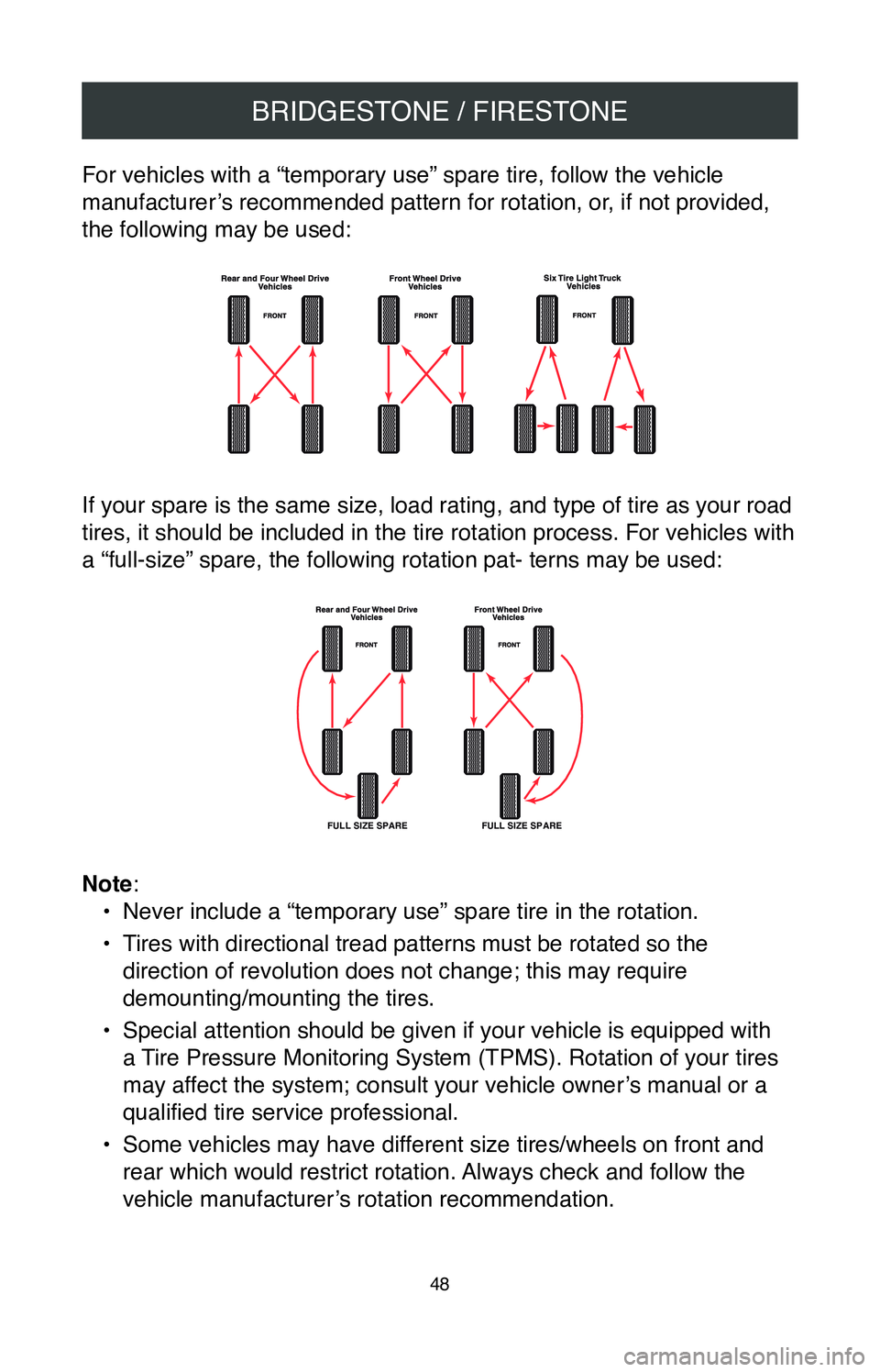
BRIDGESTONE / FIRESTONE
48
For vehicles with a “temporary use” spare tire, follow the vehicle\
manufacturer’s recommended pattern for rotation, or, if not provided,
the following may be used:
If your spare is the same size, load rating, and type of tire as your ro\
ad
tires, it should be included in the tire rotation process. For vehicles \
with
a “full-size” spare, the following rotation pat- terns may be used:
FULL SIZE SPAREFULL SIZE SPARE
Note:
•
Never include a “temporary use” spare tire in the rotation.
•
Tires with directional tread patterns must be rotated so the
direction of revolution does not change; this may require
demounting/mounting the tires.
•
Special attention should be given if your vehicle is equipped with
a Tire Pressure Monitoring System (TPMS). Rotation of your tires
may affect the system; consult your vehicle owner’s manual or a
qualified tire service professional.
•
Some vehicles may have different size tires/wheels on front and
rear which would restrict rotation. Always check and follow the
vehicle manufacturer’s rotation recommendation.
Page 51 of 260
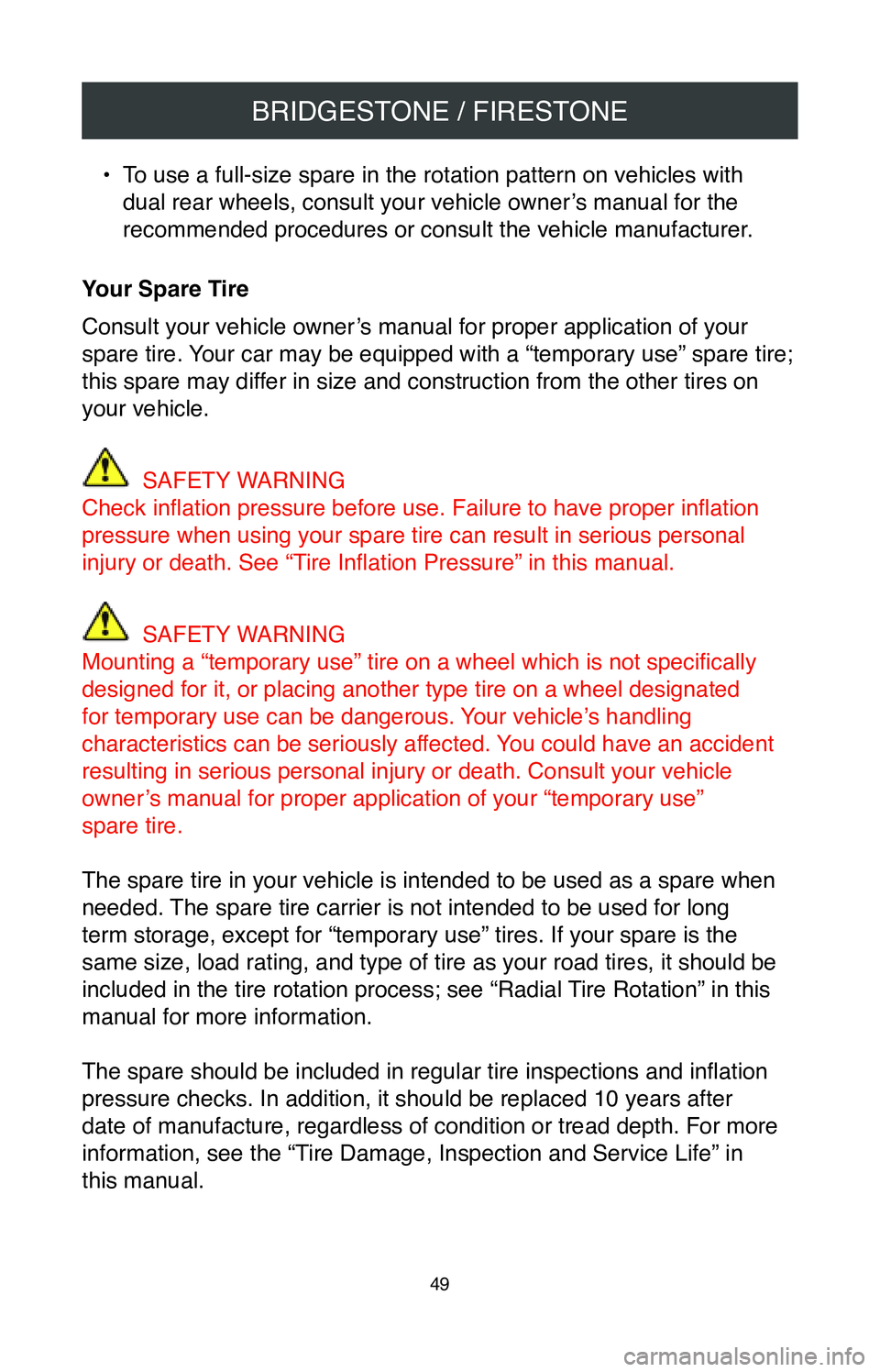
BRIDGESTONE / FIRESTONE
49
• To use a full-size spare in the rotation pattern on vehicles with
dual rear wheels, consult your vehicle owner’s manual for the
recommended procedures or consult the vehicle manufacturer.
Your Spare Tire
Consult your vehicle owner’s manual for proper application of your
spare tire. Your car may be equipped with a “temporary use” spare tire;
this spare may differ in size and construction from the other tires on
your vehicle.
SAFETY WARNING
Check inflation pressure before use. Failure to have proper inflation
pressure when using your spare tire can result in serious personal
injury or death. See “Tire Inflation Pressure” in this manual.
SAFETY WARNING
Mounting a “temporary use” tire on a wheel which is not specifically
designed for it, or placing another type tire on a wheel designated
for temporary use can be dangerous. Your vehicle’s handling
characteristics can be seriously affected. You could have an accident
resulting in serious personal injury or death. Consult your vehicle
owner’s manual for proper application of your “temporary use”
spare tire.
The spare tire in your vehicle is intended to be used as a spare when
needed. The spare tire carrier is not intended to be used for long
term storage, except for “temporary use” tires. If your spare is t\
he
same size, load rating, and type of tire as your road tires, it should b\
e
included in the tire rotation process; see “Radial Tire Rotation” in this
manual for more information.
The spare should be included in regular tire inspections and inflation
pressure checks. In addition, it should be replaced 10 years after
date of manufacture, regardless of condition or tread depth. For more
information, see the “Tire Damage, Inspection and Service Life” in
this manual.
Page 60 of 260

BRIDGESTONE / FIRESTONE
58
Maximum Load and Inflation: The maximum load and maximum
inflation pressure is marked on each sidewall in metric and English
units. For example:
MAX LOAD 685 kg (1510 lbs) AT 240 kPa (35 psi) MAX PRESS
Note: The load and inflation values marked on the tire sidewall are
maximum permissible values for the tire only. Never assume that these
values are the actual maximum load capacity or recommended tire
pressure values for your vehicle. See “Tire Inflation Pressure,” “Tips
for Safe Tire Inflation,” and “Tips for Safe Loading” in this manual.
Ply Composition and Materials : The actual number of plies in
the sidewall and tread area and the generic name(s) of their cord
material(s) are marked on at least one sidewall. For example:
TREAD 2 PLY POLYESTER + 2 STEEL SIDEWALL 2 PLY POLYESTER
Radial: Radial ply tires will have the word “radial” on at least one
sidewall. An “R” in the tire size designation also indicates radial ply
construction.
Tubeless or Tube Type: Tires are marked as either “tubeless” or “tube
type,” whichever is applicable, on at least one sidewall.
Uniform Tire Quality Grading
The Uniform Tire Quality Grading (“UTQG”) standards are intended to
assist you in making an informed choice in your purchase of passenger
car tires by providing information indicating relative performance of
these tires in the areas of tread wear, wet braking traction (straight-
ahead), and temperature resistance. All passenger car tires must
conform to federal safety requirements in addition to these grades.
Treadwear
The treadwear grade is a comparative rating based on the wear rate
of the tire when tested under controlled conditions on a specified
government test course. For example, a tire graded 150 would wear
one and one half (1 1/2) times as well on the government course as a
Page 78 of 260
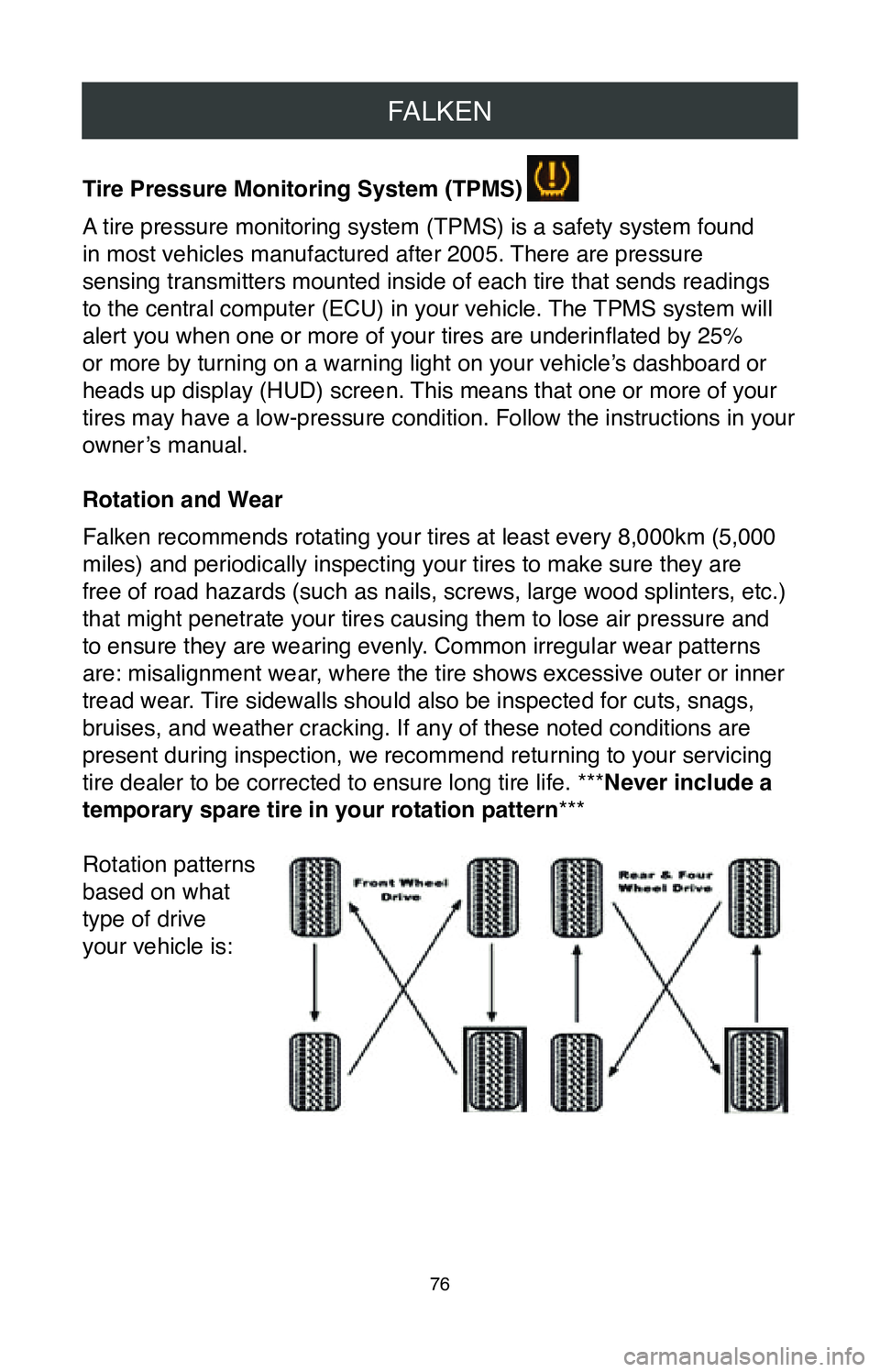
FALKEN
76
Tire Pressure Monitoring System (TPMS)
A tire pressure monitoring system (TPMS) is a safety system found
in most vehicles manufactured after 2005. There are pressure
sensing transmitters mounted inside of each tire that sends readings
to the central computer (ECU) in your vehicle. The TPMS system will
alert you when one or more of your tires are underinflated by 25%
or more by turning on a warning light on your vehicle’s dashboard or
heads up display (HUD) screen. This means that one or more of your
tires may have a low-pressure condition. Follow the instructions in your
owner’s manual.
Rotation and Wear
Falken recommends rotating your tires at least every 8,000km (5,000
miles) and periodically inspecting your tires to make sure they are
free of road hazards (such as nails, screws, large wood splinters, etc.)
that might penetrate your tires causing them to lose air pressure and
to ensure they are wearing evenly. Common irregular wear patterns
are: misalignment wear, where the tire shows excessive outer or inner
tread wear. Tire sidewalls should also be inspected for cuts, snags,
bruises, and weather cracking. If any of these noted conditions are
present during inspection, we recommend returning to your servicing
tire dealer to be corrected to ensure long tire life. ***Never include a
temporary spare tire in your rotation pattern***
Rotation patterns
based on what
type of drive
your vehicle is:
Page 80 of 260

FALKEN
78
• A plug and patch or plug/patch combo should be used to effectively
repair a tire puncture.
•
If anything seems questionable at any time during the repair
process, ask your service advisor for more details and/or call the
tire manufacturer to make sure the tire’s warranty isn’t
being voided.
Tire Mix Usage
SAFETY WARNING
Never mix tires of different size or construction and/or type on any axle.
(Except for temporary use as a spare tire.) Always refer to the vehicle’s
owner manual for proper tire fitments.
Tire Speed Ratings
Falken recommends replacing your tire(s) with the same speed rating
as the original tires equipped on your vehicle.
It is okay to use a lower speed rated tire when using winter tires.
However, speeds should be reduced to match the tires new “maximum”
speed capability.
Any tire that is repaired, damaged, abused, altered from its original
state or retreaded voids the speed rating on that particular tire and
should be considered a non-speed rated tire.
SAFETY WARNING
Falken does not recommend the use of mixing different speed ratings
on a vehicle. This can cause poor handling and unpredictable steering.
High Performance, Low Aspect Ratio Tires
Various new vehicles come equipped with high performance and/or
low aspect ratio tires from the factory. These tires generally provide
increased vehicle handling characteristics, but may also have
engineering performance trade-offs related with their designs. Low
aspect ratio tires have reduced sidewall heights and may be more
vulnerable to damage from road hazards, potholes, and other objects,
Page 108 of 260

KENDA
106
must be inspected by any tire dealer at once. Use of a damaged tire
could result in sudden tire destruction.
All tires will wear out faster when subjected to high speeds as well as
hard cornering, rapid starts, sudden stops, frequent driving on roads
which are in poor condition, and off road use. Roads with holes and
rocks or other objects can damage tires and cause misalignment of
your vehicle. When you drive on such roads, drive on them carefully
and slowly, and before driving at normal or highway speeds, examine
your tires for any damage, such as cuts or penetrations.
Worn Out Tires Are Dangerous
Tires contain ‘Wear-Bars” in the grooves of the tire tread which show
up when only 2/32nds of an inch (1.6mm) tread is remaining. At this
stage, your tires must be replaced. Tires worn beyond this stage
are dangerous.
Do Not Overload
Driving On Any Overloaded Tire Is Dangerous
The maximum load rating of your tires is marked on the tire sidewall.
Do not exceed these ratings. Follow the loading instructions of the
manufacturer of your vehicle and this will insure that your tires are no\
t
overloaded. Tires which are loaded beyond their maximum allowable
loads for the particular application will build up excessive heat that m\
ay
result in sudden tire destruction.
Do not exceed the gross axle weight ratings for any axle on your
vehicle. TRAILER TOWING
If you anticipate towing a trailer, you should see any tire dealer for
advice concerning the correct size of tire and pressures. Tire size
and pressures will depend upon the type and size of trailer and hitch
utilized, but in no case must the maximum cold inflation pressure of
tire load rating be exceeded. Check the tire placard and the owner’s
manual supplied by the manufacturer of your vehicle for further
recommendations on trailer towing.
Page 109 of 260
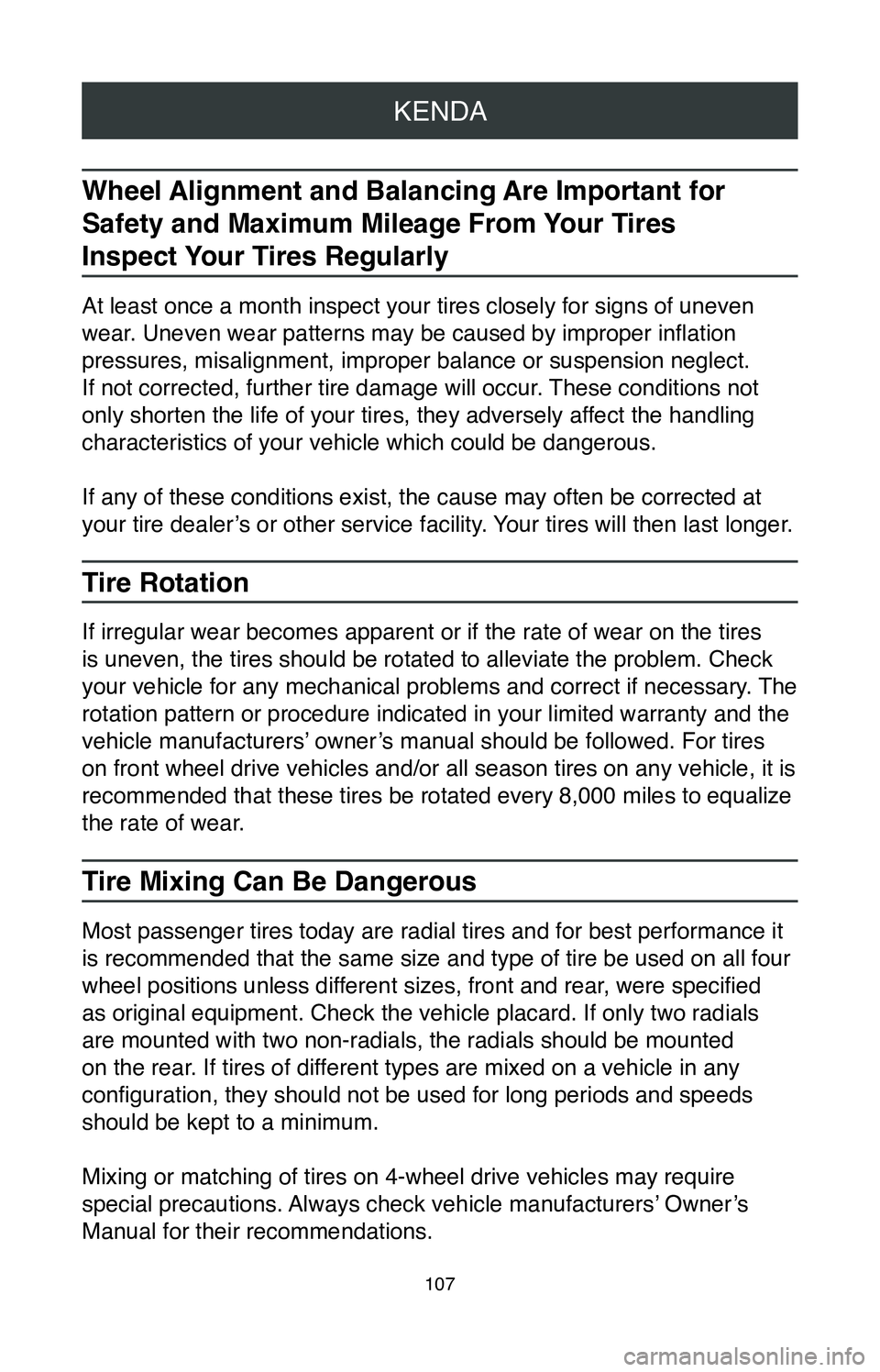
KENDA
107
Wheel Alignment and Balancing Are Important for
Safety and Maximum Mileage From Your Tires
Inspect Your Tires Regularly
At least once a month inspect your tires closely for signs of uneven
wear. Uneven wear patterns may be caused by improper inflation
pressures, misalignment, improper balance or suspension neglect.
If not corrected, further tire damage will occur. These conditions not
only shorten the life of your tires, they adversely affect the handling
characteristics of your vehicle which could be dangerous.
If any of these conditions exist, the cause may often be corrected at
your tire dealer’s or other service facility. Your tires will then last longer.
Tire Rotation
If irregular wear becomes apparent or if the rate of wear on the tires
is uneven, the tires should be rotated to alleviate the problem. Check
your vehicle for any mechanical problems and correct if necessary. The
rotation pattern or procedure indicated in your limited warranty and the\
vehicle manufacturers’ owner’s manual should be followed. For tires
on front wheel drive vehicles and/or all season tires on any vehicle, it\
is
recommended that these tires be rotated every 8,000 miles to equalize
the rate of wear.
Tire Mixing Can Be Dangerous
Most passenger tires today are radial tires and for best performance it \
is recommended that the same size and type of tire be used on all four
wheel positions unless different sizes, front and rear, were specified
as original equipment. Check the vehicle placard. If only two radials
are mounted with two non-radials, the radials should be mounted
on the rear. If tires of different types are mixed on a vehicle in any
configuration, they should not be used for long periods and speeds
should be kept to a minimum.
Mixing or matching of tires on 4-wheel drive vehicles may require
special precautions. Always check vehicle manufacturers’ Owner’s
Manual for their recommendations.
Page 110 of 260

KENDA
108
Tire Alterations Are Dangerous
Do not perform any alteration on your tires. Alterations may prevent
proper performance, leading to tire damage, which can result in
sudden tire destruction. Tires which have been altered are excluded
from warranty coverage.
Repairs. See Any Tire Dealer At Once
If any tire has sustained a puncture, have the tire dismounted and
inspected internally by any tire dealer for possible damage that may
have occurred.
Punctures in the tread of passenger tires which do not exceed 1/4-inch
(6mm) in diameter can be repaired by following Rubber Manufacturers’
Association (RMA) recommended repair procedures. Do not use
externally applied plug repairs. Punctures outside the tread area
should not be repaired.
If the tire has a puncture in the tread which exceeds 1/4-inch (6mm) or
if more than one radial cable per casing ply is damaged, the tire must
be replaced.
Storage
Tires should be stored in a cool dry place indoors so that there is no
danger of water collecting inside them. Serious problems occur with
tube type tires when they are mounted with water trapped between the
tire and the tube. Due to pressurization, the liquid can pass through
the inner liner and into the casing plies. This can result in sudden lire
failure. Most of the problems of this nature, encountered with tube type\
tires, have been due to improper storage which permitted water to
enter the casing between the tire and tube prior to mounting.
When tires are stored they should be stored in a cool place away from
sources of heat and ozone such as hot pipes and electric motors. Be
sure that surfaces of which tires are stored are clean and free from
grease, gasoline or other substances which could deteriorate the
rubber. Tires exposed to these materials and/or excessive heat for a
Page 112 of 260

KENDA
11 0
the replacement tire must have the same or higher speed rating
symbol if the speed capability of the vehicle is to be maintained. IF
THE REPLACEMENT TIRE IS NOT SPEED RATED, THE SPEED
CAPABILITY OF THE VEHICLE IS LIMITED BY THE SPEED
CAPABILITY OF THE REPLACEMENT TIRE. A Kenda-produced
non-speed rated tire’s maximum speed is 85 m.p.h. (137 kmph).
Tire Mounting Can Be Dangerous
Tire mounting can be dangerous and should be done by trained
persons using proper tools and procedures. Your tires should be
mounted on wheels which are in good, clean condition. Bent, chipped
or rusted wheels may cause tire damage. Have your dealer check the
size and condition of your wheels before mounting new tires. Be sure
rim/Wheel manufacturer’s recommendations are followed. The inside
of the tire must be free of foreign material.
Old valves may leak. When new tubeless tires are mounted, have new
valves of the correct type installed. Be sure that all of your valves ha\
ve
suitable valve caps.
The sidewalls of radial tires flex more than non-radial tires. Because of
this, tube-type radial tires require special tubes. Radial tubes should be
used with radial tube-type tires. The use of other tubes, not designed
for radial tires, will result in tube failure causing sudden tire destru\
ction.
Always use a new tube when mounting a new tube type tire.
Kenda
Designed for Your Journey
7095 Americana Parkway
Reynoldsburg, OH 43068
KendaTire.com
Page 127 of 260
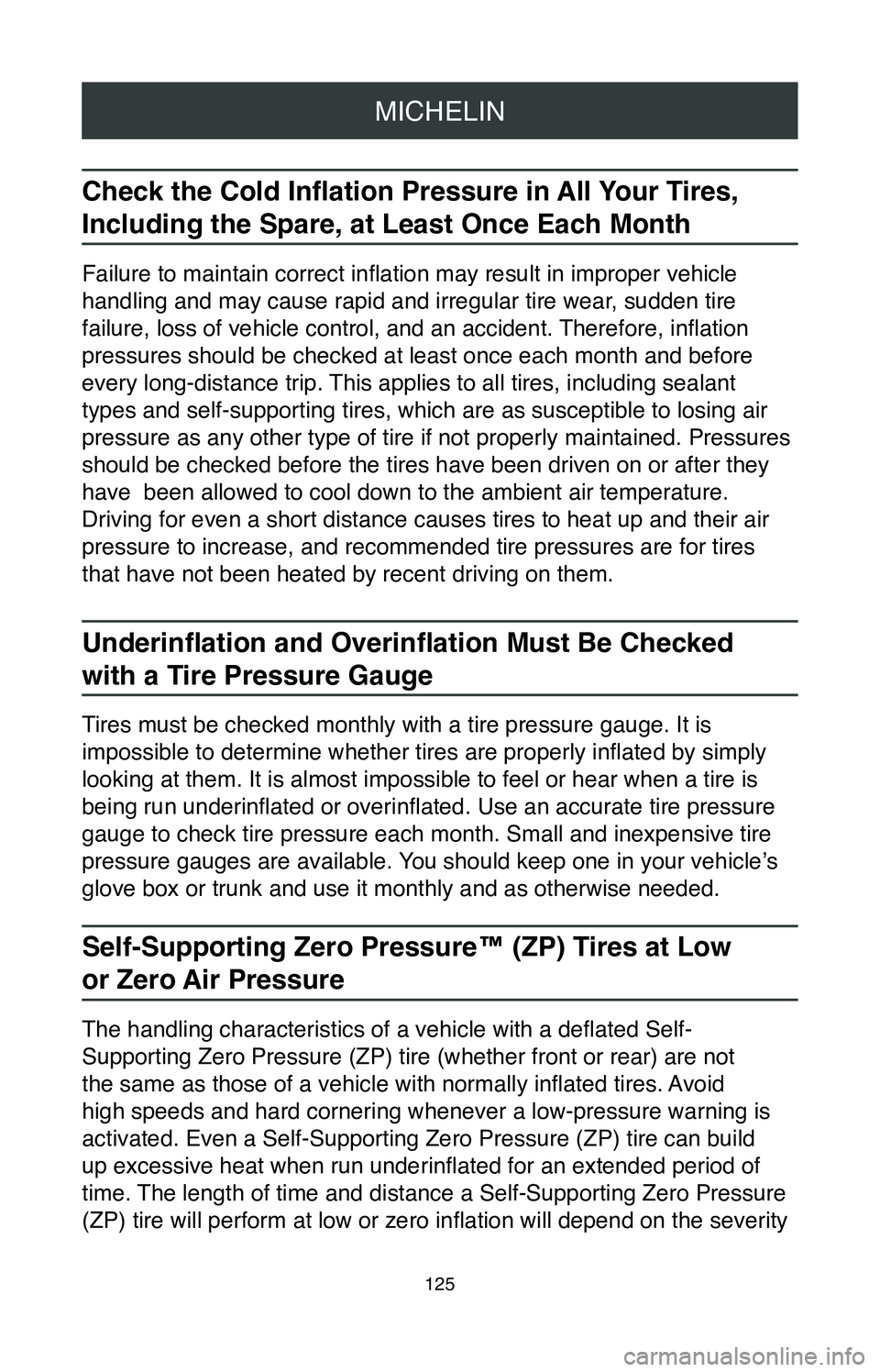
MICHELIN
125
Check the Cold Inflation Pressure in All Your Tires,
Including the Spare, at Least Once Each Month
Failure to maintain correct inflation may result in improper vehicle
handling and may cause rapid and irregular tire wear, sudden tire
failure, loss of vehicle control, and an accident. Therefore, inflation
pressures should be checked at least once each month and before
every long-distance trip. This applies to all tires, including sealant
types and self-supporting tires, which are as susceptible to losing air
pressure as any other type of tire if not properly maintained. Pressures\
should be checked before the tires have been driven on or after they
have been allowed to cool down to the ambient air temperature.
Driving for even a short distance causes tires to heat up and their air \
pressure to increase, and recommended tire pressures are for tires
that have not been heated by recent driving on them.
Underinflation and Overinflation Must Be Checked
with a Tire Pressure Gauge
Tires must be checked monthly with a tire pressure gauge. It is
impossible to determine whether tires are properly inflated by simply
looking at them. It is almost impossible to feel or hear when a tire is \
being run underinflated or overinflated. Use an accurate tire pressure
gauge to check tire pressure each month. Small and inexpensive tire
pressure gauges are available. You should keep one in your vehicle’s
glove box or trunk and use it monthly and as otherwise needed.
Self-Supporting Zero Pressure™ (ZP) Tires at Low
or Zero Air Pressure
The handling characteristics of a vehicle with a deflated Self-
Supporting Zero Pressure (ZP) tire (whether front or rear) are not
the same as those of a vehicle with normally inflated tires. Avoid
high speeds and hard cornering whenever a low-pressure warning is
activated. Even a Self-Supporting Zero Pressure (ZP) tire can build
up excessive heat when run underinflated for an extended period of
time. The length of time and distance a Self-Supporting Zero Pressure
(ZP) tire will perform at low or zero inflation will depend on the severity